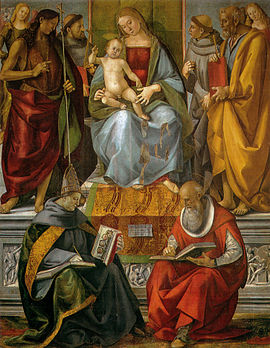Description
The panel's subject is a Holy Conversation, inspired by similar works from the Venetian area, such as Antonello da Messina's San Cassiano Altarpiece and its derivations by Giovanni Bellini and others. Similarities include the green canvas hanging behind Mary's throne, continuing in the broccato carpet at her feet. Also of the same origin is the central cartouche with the artist's signature, derived from Flemish painting and introduced in Italy by Paduan artists.
The scene comprises two levels: on the upper one are the Virgin and the blessing Child, with the saints John the Baptist, Peter, perhaps Antony of Padua and Francis, and, at the sides, two small angels. The upper saints (with the exception of St. Peter) are of poorer quality, and were perhaps executed by the artist's workshop. Those in the foreground, which were less hastily painted, are a bishop and St. Jerome sitting and writing. The latter resembles that painted by Domenico Ghirlandaio in the church of Ognissanti at Florence.
A classical element is the frieze with the Centauromachy, which cites a sarcophagus discovered in the early 15th century at Cortona (not far from Volterra).

Fra Angelico, OP was a Dominican friar and Italian painter of the Early Renaissance, described by Giorgio Vasari in his Lives of the Artists as having "a rare and perfect talent". He earned his reputation primarily for the series of frescoes he made for his own friary, San Marco, in Florence, then worked in Rome and other cities. All his known work is of religious subjects.

An altarpiece is an work of art in painting, sculpture or relief representing a religious subject made for placing at the back of or behind the altar of a Christian church. Though most commonly used for a single work of art such as a painting or sculpture, or a set of them, the word can also be used of the whole ensemble behind an altar, otherwise known as a reredos, including what is often an elaborate frame for the central image or images. Altarpieces were one of the most important products of Christian art especially from the late Middle Ages to the era of Baroque painting.

Filippino Lippi was an Italian painter working in Florence, Italy during the later years of the Early Renaissance and first few years of the High Renaissance.

Luca Signorelli was an Italian Renaissance painter from Cortona, in Tuscany, who was noted in particular for his ability as a draftsman and his use of foreshortening. His massive frescos of the Last Judgment (1499–1503) in Orvieto Cathedral are considered his masterpiece.

Pinturicchio, or Pintoricchio, also known as Benetto di Biagio or Sordicchio, was an Italian painter during the Renaissance. He acquired his nickname because of his small stature and he used it to sign some of his artworks that were created during the fifteenth and sixteenth centuries.

Orvieto Cathedral is a large 14th-century Roman Catholic cathedral dedicated to the Assumption of the Virgin Mary and situated in the town of Orvieto in Umbria, central Italy. Since 1986, the cathedral in Orvieto has been the episcopal seat of the former Diocese of Todi as well.

Italian Renaissance painting is the painting of the period beginning in the late 13th century and flourishing from the early 15th to late 16th centuries, occurring in the Italian Peninsula, which was at that time divided into many political states, some independent but others controlled by external powers. The painters of Renaissance Italy, although often attached to particular courts and with loyalties to particular towns, nonetheless wandered the length and breadth of Italy, often occupying a diplomatic status and disseminating artistic and philosophical ideas.
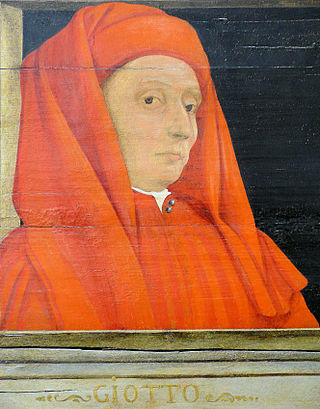
Giotto di Bondone, known mononymously as Giotto and Latinised as Giottus, was an Italian painter and architect from Florence during the Late Middle Ages. He worked during the Gothic and Proto-Renaissance period. Giotto's contemporary, the banker and chronicler Giovanni Villani, wrote that Giotto was "the most sovereign master of painting in his time, who drew all his figures and their postures according to nature" and of his publicly recognized "talent and excellence". Giorgio Vasari described Giotto as making a decisive break from the prevalent Byzantine style and as initiating "the great art of painting as we know it today, introducing the technique of drawing accurately from life, which had been neglected for more than two hundred years".

The Sant'Onofrio Altarpiece is a painting by the Italian Renaissance painter Luca Signorelli, housed in the Museo dell'Opera del Duomo in the Cathedral of Perugia, Italy. It was painted for the church in 1484, commissioned by bishop Jacopo Vagnucci, a native of Cortona, Signorelli's birthplace.
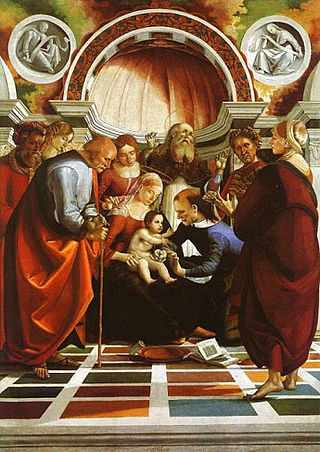
The Circumcision is a painted altarpiece of the Circumcision of Jesus by the Italian Renaissance painter Luca Signorelli, in the National Gallery in London, dated to c. 1490–1491.
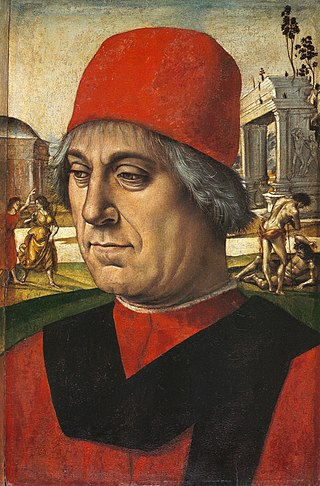
The Portrait of a Man is a painting by the Italian Renaissance artist Luca Signorelli, dated to c. 1492 and housed in the Gemäldegalerie, Berlin.

The Martinengo Altarpiece is a painting by the Italian High Renaissance painter Lorenzo Lotto, finished in 1516. It is housed in the church of Santi Bartolomeo e Stefano in Bergamo in northern Italy.

The Madonna and Child Enthroned with Saints John the Baptist and Sebastian is a painting by the Italian Renaissance artist Pietro Perugino, executed in 1493 and housed in the Uffizi Gallery, Florence.

The Annunciation with St. Margaret and St. Ansanus is a painting by the Italian Gothic artists Simone Martini and Lippo Memmi, now housed in the Uffizi Gallery in Florence, Italy. It is a wooden triptych painted in tempera and gold, with a central panel having double size. Considered Martini's masterwork and one of the most outstanding works of Gothic painting, the work was originally painted for a side altar in the Siena Cathedral.

Volterra Cathedral is a Roman Catholic cathedral in Volterra, Italy, dedicated to the Assumption of the Virgin Mary. It is the seat of the bishop of Volterra.

The Pinacoteca Comunale ofCittà di Castello is the main museum of paintings and arts of Umbria Italian Region, alongside the Perugia's National gallery, and it's housed in a renaissance palace, generally preserved in its original form.

The Arcevia Altarpiece is a 1508 oil on panel painting by Luca Signorelli, shown in the collegiate church of San Medardo in Arcevia, for which it was originally painted. It is signed below the Madonna's feet.LUCAS. SIGNORELLUS / PINGEBAT M. D. VIII

Adoration of the Magi is a painting in tempera on wood panel by Luca Signorelli (1450–1523) and his assistants, executed c. 1493–1494, and now in the Louvre in Paris. It was probably the first painting he produced in Città di Castello, and originally hung over the main altar of the monastery church of Sant'Agostino. The surface displayed within the frame is 331 cm by 245.5 cm. In late 2022 it was not on display.
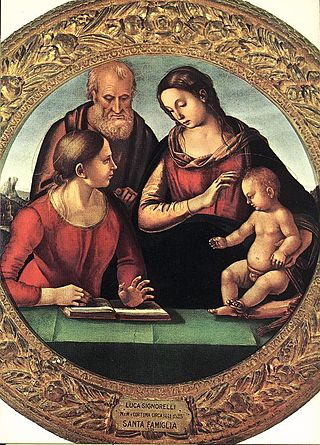
Holy Family or Holy Family with a Female Saint is a tempera on panel painting by Luca Signorelli, created c. 1490–1495, now in the Galleria Palatina in Florence.

The Pinacoteca e Museo Civico di Volterra is located in the Palazzo Minucci-Solaini on via de' Sarti #1 in the town of Volterra, province of Pisa, region of Tuscany, Italy.
